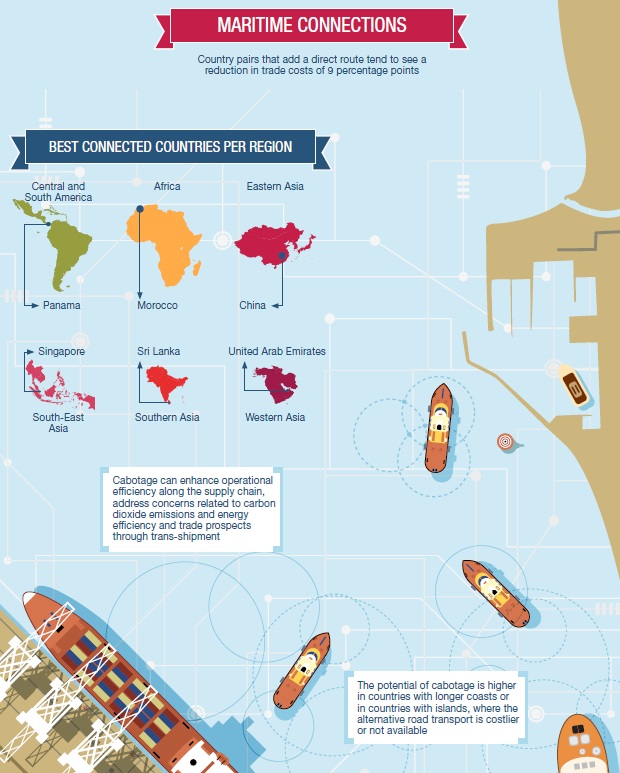News
Low shipping connectivity makes weaker economies more vulnerable

In a globalized world, trade, communication and finance depend on the possibilities for people, companies and societies to connect, and there is a growing rift between the best- and worst-connected countries, a new United Nations report says.
Published on 25 October, the UNCTAD Review of Maritime Transport 2017 states that low shipping connectivity continues to undermine the access of smaller and weaker economies to global markets and that improving this requires modernizing their seaports and cabotage regimes, and reforming customs and other import-export procedures.
Many landlocked developing countries, small island developing States and least developed countries are among those most affected, given their access to fewer, less frequent, less reliable and more costly transport connections.
“Our research shows that planning and forecasts can be significantly improved if data on maritime transport networks are included in the relevant policy processes, such as negotiating trade deals and transport infrastructure development plans,” notes UNCTAD Secretary-General Mukhisa Kituyi, ahead of the report's release.
National, regional and intercontinental liner shipping services should be interconnected to the extent possible. In many countries today, domestic shipping services for cabotage transport are protected from foreign competition. Such market restrictions can lead to unnecessary inefficiencies and a loss of maritime connectivity.
Well-designed policies that allow – under clearly defined conditions – international shipping lines to also carry domestic trade or international cargo from feeder vessels can enhance both the competitiveness of a nation’s seaports and the access of importers and exporters to international shipping services.
“Fostering competition among ports is important to ensure that port operators maximize efficiency and pass on efficiency gains to their clients,” says Shamika N. Sirimanne, Director of the Division on Technology and Logistics of UNCTAD.
Inter-port competition should not be limited to national seaports, but to ports of neighbouring countries as well. Improved maritime connectivity thus also depends on effective port hinterland access through inland and multimodal transport connections. Efficient regional trucking markets, inland waterways, rail and road infrastructure, and transit regimes are all important instruments to enhance inter-port competition.
Transit can be facilitated in line with international standards and recommendations, including those of the United Nations, the World Customs Organization and the World Trade Organization.
Customs and other border agencies need to continuously modernize to speed up the movement of goods. UNCTAD work helping countries automate customs procedures and integrate other trade-related government processes shows that these efforts can reduce transaction costs, shorten cargo dwell time and increase transparency.
Regional leaders
The key nodes of the global shipping network are Malacca, Panama, the Strait of Gibraltar and Suez, and traffic is denser in general in the northern hemisphere, with exceptions such as the areas around Mauritius, South Africa and Santos, Brazil.
On the west coast of South America, Panama is the best-connected country of the subregion, thanks in part to the Panama Canal, which has encouraged the establishment of trans-shipment ports.
On the east coast of South America, Argentina, Brazil and Uruguay are served by the same lines. Although Uruguay is a much smaller economy, it accommodates the same services, not only for its own imports and exports, but also for transit cargo from Paraguay and trans-shipment services into Argentina and Brazil, where cabotage restrictions limit the trans-shipment potential of domestic ports.
In Africa, the best-connected countries are Egypt, Morocco and South Africa, benefitting from their geographical position at the continent’s corners.
On the Arabian Peninsula, the United Arab Emirates, with its hub port in Dubai, has maintained the highest liner shipping connectivity index of the subregion.
In Southern Asia, Sri Lanka has bypassed its neighbours. Colombo accommodates large container ships that are deployed on services between Asia and Europe, as well as some services to Africa and South America.
In South-East Asia, Singapore and Malaysia are largely served by the same lines in their Asia-Europe services, and their liner shipping connectivity index moves mostly in parallel.
In Eastern Asia, China boasts the highest liner shipping connectivity index, as its ports are the world’s major loading locations.

Missing connections
More than 80% of country pairs do not have a direct connection. This includes large trading nations that lie across the same ocean, for example Brazil and Nigeria.
“A key question for trade and transport analysts is whether there are no direct connections between the two countries because there is not enough demand, or whether there is not much trade between them because the two trading partners are not well connected,” notes Jan Hoffmann, Chief of the Trade Logistics Branch of UNCTAD.
The report explains that lacking a direct maritime connection with a trade partner is associated with lower export values – up to 40% lower when there is an additional trans-shipment – and that country pairs can reduce trade costs by 9% when they add a direct maritime connection.
UNCTAD has led the research on shipping connectivity since the first publication of the UNCTAD liner shipping connectivity index in 2004.
Download: Review of Maritime Transport 2017 (PDF, 11 MB)




